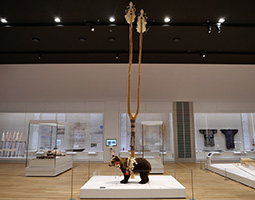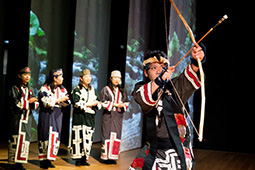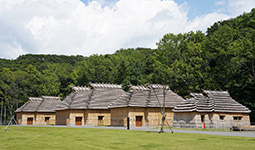INDEX
- English
- 日本語

The National Ainu Museum and Park (Upopoy) (Image is for illustration purposes) - English
- 日本語

The National Ainu Museum

About 800 items, including hunting tools and art, are exhibited at the National Ainu Museum 
Demonstration of an Ainu traditional performing art at the Cultural Exchange Hall 
Traditional Ainu houses (cise) recreated in the National Ainu Park
December 2020
Upopoy: A Symbolic Space for Ethnic Harmony

In July 2020, the National Ainu Museum and Park, nicknamed Upopoy, opened in the town of Shiraoi, Hokkaido as a center from which to “revitalize and expand the Ainu culture.”

The Ainu are an indigenous people from the northern region of the Japanese archipelago, predominantly Hokkaido, and have developed a distinctive, rich culture that includes the unique Ainu language, a spirituality that holds that spirits dwell in every part of the natural world, traditional dances that are performed at a variety of events, uniquely patterned embroidery and carved wooden art.
According to the National Ainu Museum website, the history of the Ainu (“Ainu” means humans in the Ainu language) stretches back 30,000 years, to when humans first came to Hokkaido. The Ainu were hunter-gatherer-fishers, but in around the seventh century they began to grow cereals. The Ainu actively traded with people overseas and created a unique culture.
From the seventeenth century, however, Ainu society gradually became absorbed by the Japanese economy and society. Until the nineteenth century, the Ainu lived in Hokkaido, the islands around Hokkaido and the northern parts of the Tohoku region. Today, many Ainu people still live in Hokkaido, while some Ainu live in other parts of Japan, particularly in the Kanto region, and overseas.

Promoting and raising public awareness of Ainu culture are facing several challenges. The existence of the Ainu language and traditional crafts is in crisis as the number of people able to pass on these traditions declines, while levels of understanding regarding Ainu history and culture remain low.
To overcome these challenges, the government’s Council for Ainu Policy Promotion stated in July 2009 that the establishment of “a symbolic space for ethnic harmony” would be key to a policy based on the recognition of the Ainu as an indigenous people. Upopoy, which means “singing together in a large group” in the Ainu language, has been established as a base for the revitalization and expansion of Ainu culture, an invaluable culture that is at risk of extinction, and as a “symbol of the building of a forward-looking, vibrant society with a rich, diverse culture in which indigenous people are treated with respect and dignity without discrimination.”
In July 2020, Upopoy opened in Shiraoi in southwest Hokkaido, facing the Pacific Ocean. By limited express train, Shiraoi is about 40 minutes from New Chitose Airport, and it is about 1 hour from Sapporo. The foundations of Shiraoi were laid by the Ainu, and the town has many facilities to pass down Ainu traditions and culture amid beautiful natural surroundings.

The National Ainu Museum in Upopoy has a collection of about 10,000 items, about 800 of which are permanently exhibited exploring six themes. In the Our Language area, the Ainu language, stories, place names and current initiatives to promote its use are explained. Visitors can hear narration in the Ainu language, and there are games enabling visitors to study the pronunciation and grammar of the Ainu language. Videos explaining place names and conversational Ainu are also displayed. In the Our Universe area, spirituality, a central aspect of Ainu culture, is described. The Ainu belief that ramat (spirit) exists all around us is explained using graphics.
In the open-air center, the National Ainu Park, visitors are able to experience Ainu culture through dance, cooking and traditional crafts. For example, the Cultural Exchange Hall (uekari cise) features traditional Ainu mouth harp, or mukkuri, performances and traditional Ainu dances that are inscribed on the UNESCO Representative List of the Intangible Cultural Heritage of Humanity. At the Workshop (yayhanokkar cise), visitors are able to make and taste Ainu cuisine and play traditional Ainu instruments such as the mukkuri.

“Visitors love the carved wooden handicrafts, embroidery and the experience of preparing food. We would like to provide opportunities to as many people as possible to experience Ainu culture, while taking measures to protect them from COVID-19,” says a staff member.
NOTE: With the permission of Upopoy, this article draws on English-language materials published by the museum.

